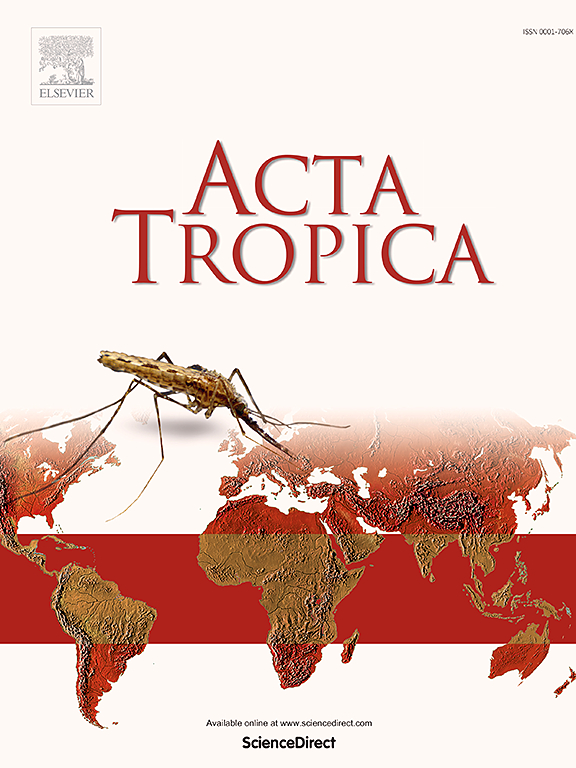Innovative trap approaches for studying Phlebotomus papatasi: Emphasizing color and position
IF 2.5
3区 医学
Q2 PARASITOLOGY
引用次数: 0
Abstract
Background
Phlebotomine sand flies are important vectors of leishmaniasis globally. Sticky traps are commonly used tools for studying the biology and ecology of Phlebotomus papatasi sand flies. This study aimed to evaluate the effectiveness of colored sticky traps placed under different conditions for capturing P. papatasi in southern Iran.
Materials and Methods
Sand fly populations in Shiraz County, Fars Province, were sampled monthly using sticky traps of seven different colors positioned horizontally and vertically. Non-parametric statistical tests, including the Kruskal-Wallis test, Mann-Whitney U test, Poisson Regression model, Chi-square test, and Wilcoxon signed-rank test, were used to compare the median numbers of sand fly specimens attracted to differently colored sticky traps under various conditions and orientations.
Results
A total of 2619 sand flies, including four species, were collected, with P. papatasi being the most abundant. Male sand flies outnumbered females. The orientation and color of sticky traps significantly influenced capture rates, with vertical traps attracting more sand flies than horizontal traps. Orange, blue, and white traps were the most effective, while black traps were the least successful. Orange traps performed best under artificial light, while blue, orange, and white traps were most effective in dark night conditions. Vertical traps generally captured more males, while horizontal traps captured more females, particularly with specific colors.
Conclusions
The study highlights the importance of trap color and orientation in attracting sand flies. Understanding sand fly visual ecology and color preferences can improve trapping techniques, emphasizing the importance of careful trap design and color selection to enhance vector surveillance.
研究木瓜白蛉的创新陷阱方法:强调颜色和位置。
背景:白蛉是全球利什曼病的重要传播媒介。粘捕器是研究木瓜白蛉生物学和生态学的常用工具。本研究旨在评估在伊朗南部不同条件下放置的彩色粘捕器对木瓜青虫的捕获效果。材料与方法:利用7种不同颜色的粘捕器对法尔斯省设拉子县沙蝇种群进行每月取样。采用非参数统计检验,包括Kruskal-Wallis检验、Mann-Whitney u检验、泊松回归模型、卡方检验和Wilcoxon符号秩检验,比较不同条件和方向下不同颜色粘捕器吸引沙蝇标本的中位数。结果:共捕获沙蝇4种2619只,以木瓜沙蝇数量最多;雄性沙蝇数量多于雌性。粘性诱捕器的方向和颜色对捕获率有显著影响,垂直诱捕器比水平诱捕器吸引更多的沙蝇。橙色、蓝色和白色陷阱是最有效的,而黑色陷阱是最不成功的。橙色陷阱在人造光下效果最好,而蓝色、橙色和白色陷阱在暗夜条件下最有效。垂直陷阱通常捕获更多的雄性,而水平陷阱捕获更多的雌性,特别是具有特定颜色的。结论:本研究强调了捕蝇器的颜色和方向对吸引沙蝇的重要性。了解沙蝇的视觉生态和颜色偏好可以提高捕获技术,强调精心设计陷阱和选择颜色对加强媒介监测的重要性。
本文章由计算机程序翻译,如有差异,请以英文原文为准。
求助全文
约1分钟内获得全文
求助全文
来源期刊

Acta tropica
医学-寄生虫学
CiteScore
5.40
自引率
11.10%
发文量
383
审稿时长
37 days
期刊介绍:
Acta Tropica, is an international journal on infectious diseases that covers public health sciences and biomedical research with particular emphasis on topics relevant to human and animal health in the tropics and the subtropics.
 求助内容:
求助内容: 应助结果提醒方式:
应助结果提醒方式:


